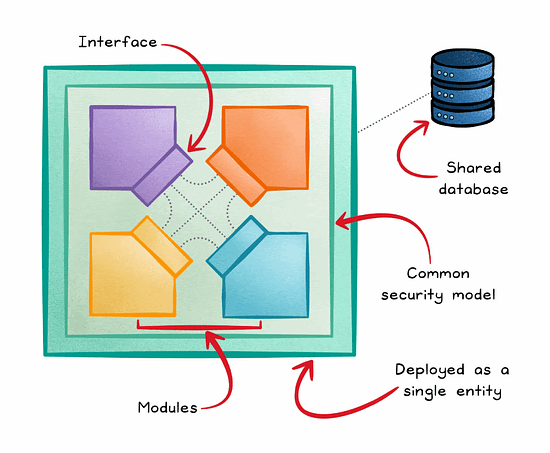Breaking Down Modular Monolithic Architecture: Blending Tradition with Innovation
(4 Minutes) | Unpacking Modular Monoliths
Get our Architecture Patterns Playbook for FREE on newsletter signup:
Unlock Windsurf Editor
Presented by Codeium
Introducing the Windsurf Editor, the first agentic IDE. All the features you know and love from Codeium’s extensions plus new capabilities such as Cascade that act as collaborative AI agents, combining the best of copilot and agent systems. This flow state of working with AI creates a step-change in AI capability that results in truly magical moments.
Breaking Down Modular Monolithic Architecture: Blending Tradition with Innovation
Modular monoliths are becoming increasingly popular in the software engineering community, offering a balance between the simplicity of traditional Monoliths and the flexibility of microservices.
This architectural style elegantly addresses complex software challenges that arise in monolithic and microservices architecture, providing engineers with a streamlined approach to building software and maintenance.
By blending the best of both worlds, modular monoliths emerge as a compelling choice in today's diverse and demanding engineering environment.
Now, let's delve deeper into what exactly a modular monolith is and how it differentiates from its counterparts.
Understanding Modular Monoliths
Modular monoliths represent a unique blend in software architecture – they are monolithic systems yet designed with an emphasis on modularity.
This allows each component, or module, to be developed independently but function cohesively within a single, unified system.
The essence of a modular monolith is captured in its:
Internal modularity: the system comprises many loosely coupled independent modules, each offering a cohesive set of functionalities within the larger system.
Single deployable unit: despite modularization, it remains a single entity for deployment, mitigating the distributed operational complexity that comes with microservices.
Shared database(s): modules typically interact with the same database(s), which simplifies data management and data integrity compared to the distributed database approach in microservices.
Modular monoliths strike a middle ground combining the straightforwardness of traditional monoliths with the modular flexibility of microservices, but without the operational complexity.
Advantages of Modular Monoliths
Simplified Complexity
Modular monoliths offer a straightforward architecture, making development and maintenance simpler than the often complex microservices approach. This simplicity is achieved through a unified codebase, which eliminates the intricacies of managing a distributed system. The result is a streamlined development process, allowing teams to focus on solving business problems rather than navigating operational complexities.
Improved Performance
In modular monoliths, the single-process architecture facilitates rapid communication between modules. This setup outpaces the slower network calls found in microservices, leading to significantly enhanced performance. Especially in scenarios demanding quick inter-module interaction, this efficiency is a key advantage, providing a smooth and responsive system.
Enhanced Data Consistency
The centralized data management approach in modular monoliths simplifies transaction handling, offering a stark contrast to the dispersed data management in microservices. This centralization ensures robust data integrity and consistency across the application, making it easier to maintain and safeguard the system's data quality and reliability.
Building a Modular Monolith
Building a modular monolith requires a careful balance of design principles and implementation strategies to ensure the system's efficiency and maintainability.
Central to this approach are loose coupling and high cohesion among modules, allowing each to operate independently within the larger system. Here are some examples:
Product Catalog Module: Manages product listings and information.
Payments Module: Handles all aspects of payment processing.
Shipping Module: Oversees shipping logistics and tracking.
Reviews Module: Manages customer reviews and feedback.
Designing these modules to be self-contained means that changes in one module have minimal impact on others, thus enhancing the system's stability and flexibility.
A crucial aspect of modular monoliths is establishing defined interfaces for communication between modules. These interfaces act as contracts, ensuring that modules interact consistently and predictably, simplifying interactions while maintaining module independence, a vital attribute for scalable and robust architecture.
In implementing a modular monolith, it's essential to focus on these clear boundaries and interfaces between modules. The goal is to create an architecture where changes in one module do not necessitate alterations in others.
Keeping an eye on future scalability and potential transitions to a Microservices architecture from the outset can also guide the initial design choices, ensuring that such transitions, if required, are smoother and more manageable.
Challenges and Considerations
While modular monoliths offer numerous benefits, they also present potential pitfalls that require careful consideration:
Risk of tight coupling: If not designed with strict adherence to modularity principles, there's a risk of creating tight coupling between modules, which can negate the benefits of this architecture.
Scaling challenges: Compared to Microservices, scaling a modular monolith can be more complex, especially in terms of handling large volumes of transactions or data.
To mitigate these challenges, certain best practices should be followed:
Maintaining Modularity: Regular refactoring is crucial to prevent codebase bloat and ensure each module remains independent and focused.
Strategies for Scaling: Planning for scalability from the outset is essential. This includes considering how the system might transition into microservices in the future if required.
The Rise of Modular Monoliths
The popularity of modular monoliths continues to rise. The combination of simplicity with modularity, scalable design, straightforward refactoring, as well as the ability to easily migrate to microservices are attractive attributes.
Martin Fowler aptly states, “You shouldn't start a new project with microservices, even if you're sure your application will be big enough to make it worthwhile.”
This perspective underscores the importance of considering modular monoliths, especially for projects where their distinct advantages align with the project's goals and complexities.
Subscribe to get simple-to-understand, visual, and engaging system design articles straight to your inbox:




